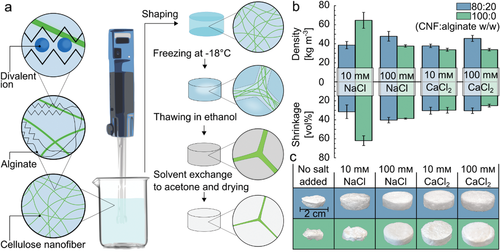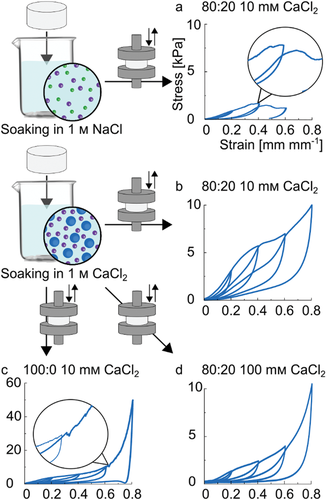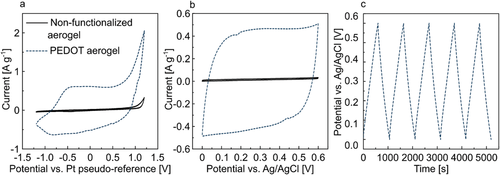Researchers in Sweden are digging deeper into the world of 3D printing and the ever-expanding, accompanying science of related materials. Their findings are outlined in the recently published ‘Ambient-Dried, 3D-Printable and Electrically Conducting Cellulose Nanofiber Aerogels by Inclusion of Functional Polymers,’ as they seek to fabricate cross-linked aerogels from both cellulose nanofibers (CNFs) and alginate.
Because they offer ‘exceptional properties’ for industrial use, aerogels are in demand. Providing features like low density and thermal conductivity, aerogels are defined as ‘a subset of gels comprising a microporous solid in which the disperse phase is gaseous.’ They are known to be useful in applications like thermal insulation, water purification, energy storage, acoustics, and as absorbents; however, they are still not used as widely as they could be in the industrial realm.
Cellulose nanofibers (CNFs), derived from wood fibers, characteristically offer high stiffness, a low thermal expansion coefficient, and elastic modulus of 138 GPa. Upon being taken from wood fiber, they have a width of 4 nm and a length of 500–2000 nm. The extraction process can be cost-prohibitive, along with requiring extensive treatment.
“The cost of the extraction process can, however, be significantly reduced by the introduction of charged moieties in the cellulose backbone. These charges lead to electrostatic repulsion between neighboring CNFs, thus counteracting the strong inter‐fibrillar interactions holding the fiber wall together and facilitating an efficient extraction of individualized CNFs. In this respect, TEMPO oxidation and carboxymethylation are two of the most used chemical pathways to introduce carboxyl groups in cellulose,” state the researchers.
Carboxymethylated CNFs are known to be suitable for forming gels that can be freeze-dried into aerogels, made of a nanocellulose that is ‘highly porous, light, and soft.’ Such materials must be wet-stable though, involving a process that can be challenging, but assisted with the addition of alginates.

a) Schematic summary of the protocol for preparing the aerogels using CNFs, alginate, and salt. b) Densities, volumetric shrinkages, and c) photographs of aerogels prepared from mixtures of different ionic strengths, alginate, and CNF contents (all photographs are presented at the same scale).
In this study, the researchers created gels of carboxymethylated CNFs and alginate, experimenting with a new technique for preparation of the aerogels that involved:
- Freezing
- Thawing
- Solvent-exchange
- Ambient drying

Assessing the wet stability of the aerogels by soaking them in different salt solutions from the dry state and submitting them to compression cycles with increasing maximum strains (sample compositions abbreviated as “x:y z × 10−3 m S” where x corresponds to the weight fraction of CNFs, y the weight fraction of alginate, z the added ionic strength, and S is the type of salt added during aerogel making; NaCl or CaCl2). The plots show that only the samples containing alginate and soaked in 1 m CaCl2 (b and d) endured the four consecutive compression cycles without noticeable structural damage and, consequently, were deemed “wet‐stable.”
CNF-alginate double networks were 3D printed and then further analyzed as the researchers evaluated the aerogels for applications like energy storage, humidity sensors, and more. First though, they were tasked with achieving wet stability, customizing mechanical properties, and shaping the materials for 3D printing.

a) Schematic summary of the protocol for the 3D printing of alginate and CNFs mixtures and subsequent aerogel fabrication. Photos of b) 3D‐printed aerogel grids before (left) and after (right) drying, c) 3D‐printed aerogels of cylindrical shape, and d) layered aerogels that were 3D‐printed by a dual‐extrusion approach where the dark layers contain a mixture of CNFs, alginate, and PEDOT:PSS, and the translucent layer a mixture of CNFs and alginate (the samples shown on (c) and (d) have been soaked in water).
While analyzing samples in a dry state, mechanical properties were ‘shown to scale with an increase in their density.’ They became wet-stable after being soaked in calcium, with the research team noting that this would render them useful for electronics applications or bioprinting of scaffolds.
“This novel post‐treatment method is simpler and greener than the current state‐of‐the‐art crosslinking methods and makes the process suitable for industrial scale manufacturing of wet‐stable aerogels,” concluded the researchers. “In combination with this, the ability to 3D print the aerogels has also been demonstrated which allows the mass production of aerogels in any printable shape, a distinct advantage for some applications such as tissue engineering where each device needs to be individually shaped with high precision.
“Finally, to demonstrate the usefulness of these aerogels in the field of organic electronics, we developed an aqueous in situ polymerization protocol to functionalize the material with PEDOT. Electrical conductivities of 146 S m−1 were achieved with loadings of 1.7 g of PEDOT:TOS per gram of aerogel. These functionalized aerogels were shown to be particularly interesting as energy storage materials, showing specific capacitances as high as 78 F g−1. Additionally, their use as mechanical deformation and relative humidity sensors has been demonstrated.”
The use of aerogels has been seen in other studies, regarding conductivity, microlattices, supercapacitors, and more. What do you think of this news? Let us know your thoughts; join the discussion of this and other 3D printing topics at 3DPrintBoard.com.

Voltammograms of a PEDOT‐functionalized aerogel and a non‐functionalized aerogel at a sweep rate of 5 mV s−1; measured in a) acetonitrile with 0.1 m TBAHFP and b) water with 0.1 m NaCl. c) Galvanostatic charge–discharge profile of a PEDOT‐functionalized aerogel at a current of 0.1 A g−1.
Subscribe to Our Email Newsletter
Stay up-to-date on all the latest news from the 3D printing industry and receive information and offers from third party vendors.
Print Services
Upload your 3D Models and get them printed quickly and efficiently.
You May Also Like
Reinventing Reindustrialization: Why NAVWAR Project Manager Spencer Koroly Invented a Made-in-America 3D Printer
It has become virtually impossible to regularly follow additive manufacturing (AM) industry news and not stumble across the term “defense industrial base” (DIB), a concept encompassing all the many diverse...
Inside The Barnes Global Advisors’ Vision for a Stronger AM Ecosystem
As additive manufacturing (AM) continues to revolutionize the industrial landscape, Pittsburgh-based consultancy The Barnes Global Advisors (TBGA) is helping shape what that future looks like. As the largest independent AM...
Ruggedized: How USMC Innovation Officer Matt Pine Navigates 3D Printing in the Military
Disclaimer: Matt Pine’s views are not the views of the Department of Defense nor the U.S. Marine Corps Throughout this decade thus far, the military’s adoption of additive manufacturing (AM)...
U.S. Congress Calls Out 3D Printing in Proposal for Commercial Reserve Manufacturing Network
Last week, the U.S. House of Representatives’ Appropriations Committee moved the FY 2026 defense bill forward to the House floor. Included in the legislation is a $131 million proposal for...

































